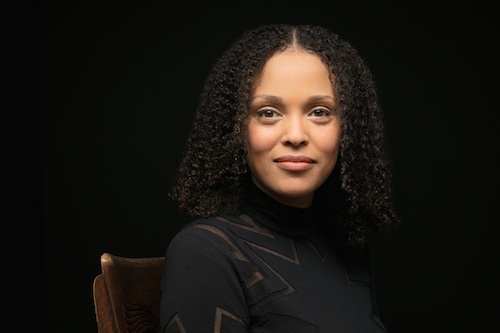Adam Vitcavage: I know this book came about after you had thought of a short story about ballet. Can you talk about the genesis of how this book came to be?
Sari Wilson: It was a long process. I would say 10 years or more, depending on how you count. I got the image of these girls—which actually became one of the first images in the novel—these young girls putting on their leotards and tights like they’re putting on armor, getting ready for battle. That image came back to me very strongly. It was from my childhood, but I hadn’t thought of it in many years.
It was emotionally powerful to me, but I didn’t know what to do with it. I tried to make it into a short story. It never worked. It just kept getting bigger and bigger. It was so different than anything I had been writing at the time.
I had my own experiences as a young girl in the ballet world that wasn’t so different than a lot of girls’ experiences. I felt that I touched on something that was related to the time period too. New York City, the late 1970s, the early 1980s, all of those Russians. Even though I never studied with the Russians, they were everywhere.
I became very fascinated with all of this, in a writerly way. I went back to the material in that capacity. I interviewed people whom I danced with. I read a ton. That’s when these characters started emerging. They took me over. The girl Mira came first. Her story is not mine, but it’s informed by my experience—people I knew, places I danced. I came to really love her and feel for her. I feared for her, but I had to follow her story until the end. I actually wrote the whole Mira storyline first. The character of Kate came later. I added Kate because I felt it needed an adult frame. She’s a very complex character. I learned—as I wrote—that they were the same person.
AV: So, you didn’t intend for them to be the same person. How and when did you decide that they needed to be the same?
SW: I already had the structure of the book. My job became figuring out who this Kate character was and what her story was. Especially how it related to Mira’s story.
AV: As I was reading the book, it became fascinating to me about how this lovely girl became this fraught middle aged woman.
SW: Yes, it became an exploration into the past. Can we ever escape from our past? How does it transform us?
AV: Speaking of the past. You say that you “stole liberally” from your childhood. How many experiences of yours found their way into Mira’s life?
SW: A lot of the setting was taken from my childhood. For example, the New York City blackout in 1977. I remember that very distinctly. A lot of the description of the ballet studios I danced in. I loved these spaces–they were windows into other worlds. A lot of the girls were based on girls I knew and danced with.
Many of the images and the feelings are drawn from my childhood. Mira’s emotional truth is my emotional truth. Her emotional experiences in the dance world were mine. At the same time, pretty much everything that happens to her is fictional.
AV: How did a character like Maurice come into Mira’s life?
SW: He is completely a fictional character. There was no Maurice in my life.
AV: But are there these types of men who are interested in these young girls? Or was that completely fictional?
SW: Historically, there have been men like this in the ballet world. There are passionate fans known as balletomanes. Ballet lore is filled with balletomanes—and examples of the extremity of their passion for this ballerina or that ballerina. If you look at the [Edgar] Degas ballet paintings, there’s often a shadowy figure. A man, shadowy and hiding behind the curtains.
Maurice is also drawn from some storybook characters. I wanted the book to have some element of a fairytale-feeling in terms of tone. Maurice came out of that. The ballet world is filled with this idea of the mysterious lurking man, and also these passionate, often obsessive balletomanes. To me, Maurice came as part of that world: the story of ballet.
In my life: there were not these men. But, I will say that to be a dancer means to always be watched. There were always people coming into the classrooms and we never knew why. They’d be standing and watching us with clipboards and then whispering and leaving. As I was remembering this world and my childhood experiences, I also remembered girls were chosen for roles in this way. Things happened because you were seen. You didn’t have a voice as a young dancer; only your body. Your body was everything.
AV: It’s just crazy to hear about these types of people. There were moments in the book that were left up to the reader’s imagination. Why was it important to leave out some details?
SW: I would say there were probably 1,000 pages that aren’t in the book—edited out over the years.
AV: That’s fascinating. I wanted more, but I’m not sure I know what I wanted of. I mean this as a compliment. I just needed more of these characters.
SW: I write from images. I write setting and characters, and the plot comes with me later. I have to throw out a lot of what I generate. One of my professors in graduate school was Tobias Wolff. Working with him taught me something about the art of leaving things out. How when you leave something out, you can create more tension and more mystery.
AV: I definitely felt that tension.
SW: I worked a lot in the later stages on the structure. How to create dramatic tension by withholding information. That was always a question I asked myself. Maybe I left out too much in the end. I don’t know. I’m going to need my readers to tell me.
AV: I appreciated the tension. I wanted these characters in my life. I need to read more about ballet because of this book.
SW: That’s awesome. I could not be more thrilled to have someone who basically didn’t know anything about ballet being captured by the mystery of it—as I was as a child. It’s a strange world, it’s a dangerous world, it’s a magical world, and largely it’s a province of girls. I’m thrilled a man would find it compelling.
AV: I read your opinion piece for The New York Times about how it is a dangerous world.
SW: I actually think it’s a good moment for ballet right now. In terms of mainstream culture at least. Misty Copeland is someone everyone is so excited about. She’s a revolutionary dancer who is really shaking things up. Then there’s also a [television show on Starz] called " Flesh and Bone" that covers a lot of the same themes as my novel.
But as much as this book is about ballet, I wanted to write a book about the human condition. Not just a ballet book. I wanted to find what was compelling and tragic and deeply human in all of these characters—and set it in the world of ballet.
AV: You did a good job with these characters. I know nothing about ballet, but I completely understood that attention that Mira wanted. Other than that human connection and the building of tension, what other things do you try to implement stylistically into your writing?
SW: I think my style comes from a lot of years of very hard work. I write a lot, but I haven’t published that much. That’s because I have to be really honest with myself. Am I putting on paper what is absolutely true? Is it the emotional truth? If it’s not then I have to keep going. I do a lot of freewriting, and then I edit most of it out. What remains is the writing that has the most energy and speaks to me the most.
It’s images and character’s voices that come to me first. I do a lot of writing to find who these people are and to figure out where they’re coming from. Then my job becomes the story. Putting everything together is actually the last piece for me. It’s a layered process.
AV: So what’s a normal writing day for you?
SW: Usually, I start where I left off. I leave a note for myself about what questions I have. I usually start out doing free writing to get underneath my conscious mind. When I start to surprise myself is when I think something is moving and interesting. If I’m just trying to generate material, my goal will be a certain number of pages in a day or a session. If I’m in the editing process, I’ll give myself a similar goal of pages to edit.
AV: Are you already onto processing the next project? Hopefully, it’s not another 10-year process for you.
SW: I hope it’s not another 10 years (laughs). I started another one. I started it last spring, and I’m very excited for it. I’m trying to do more advanced planning for this one so it doesn’t take as long. Doing more outlining ahead of time, though I’m sure it will be another layered process.
AV: Can you talk about anything of the book? The characters or emotions you’ve come up with.
SW: I really can’t. It’s too early. I just have some characters and some situations. But it’s too early.
AV: I totally get it. Is that all you’re working on, or do you have any short stories or essays?
SW: I am working on some essays related to the book and ballet. As far as short stories: not at the moment. I’m really compelled by the novel form. I think it has a lot of energy right now.
AV: What about comics at all? I know your husband is a cartoonist.
SW: My husband is a cartoonist, his name is Josh Neufeld, and we are publishing an anthology of linked short stories and comics this spring. It’s called Flashed: Sudden Stories in Comics and Prose. It’s all flash fiction. Some of it is prose and some of it is comics. They’re all in dialogue with each other. There are some great comics and great fiction writers involved. We loved putting them together.
To learn more about Sari Wilson, visit her official website, like her Facebook page, or follow her on Twitter @sariwilson.
Read or listen to more of Adam Vitcavage's interviews by visiting his official website or subscribing to his podcast "Internal Review."




































